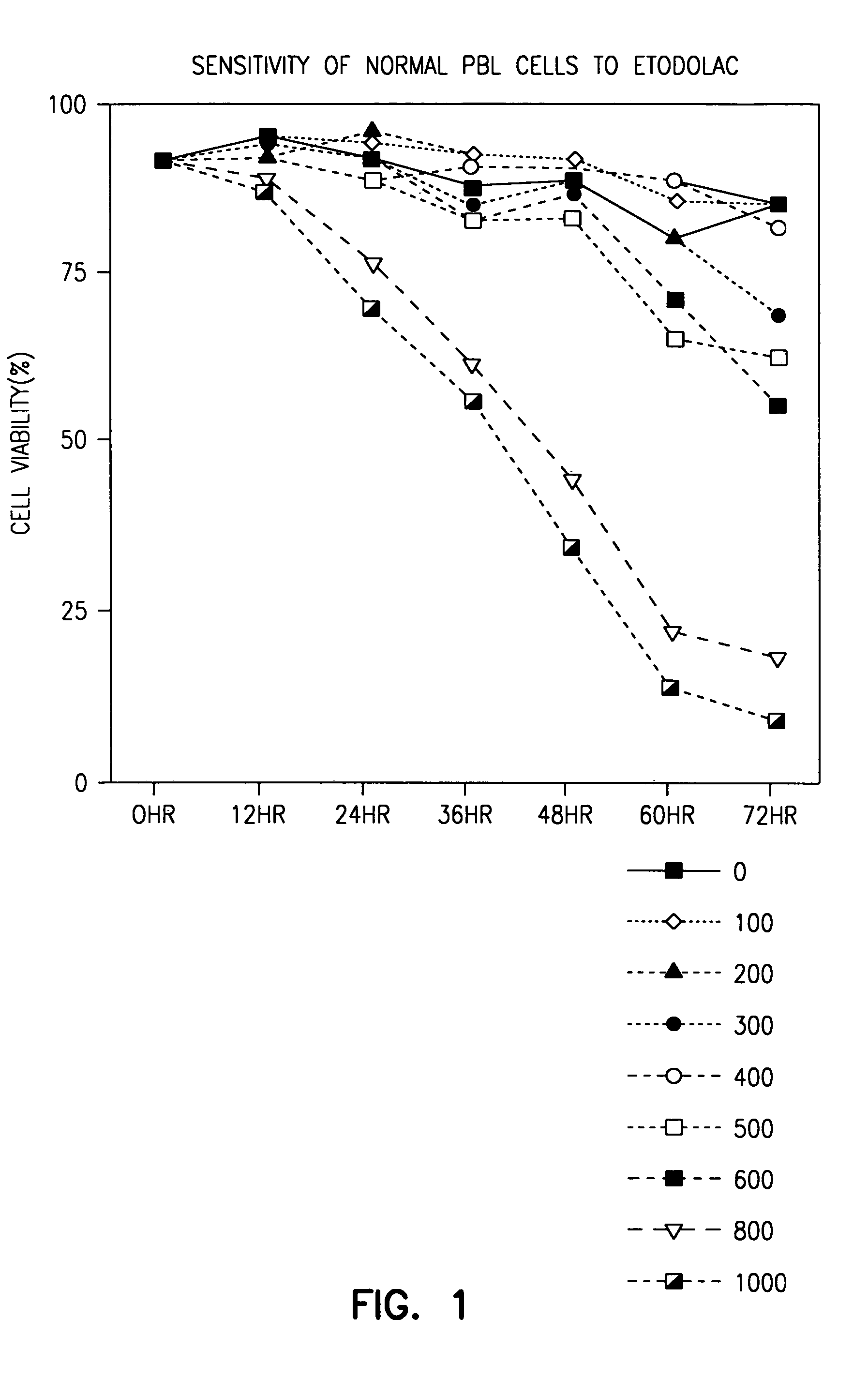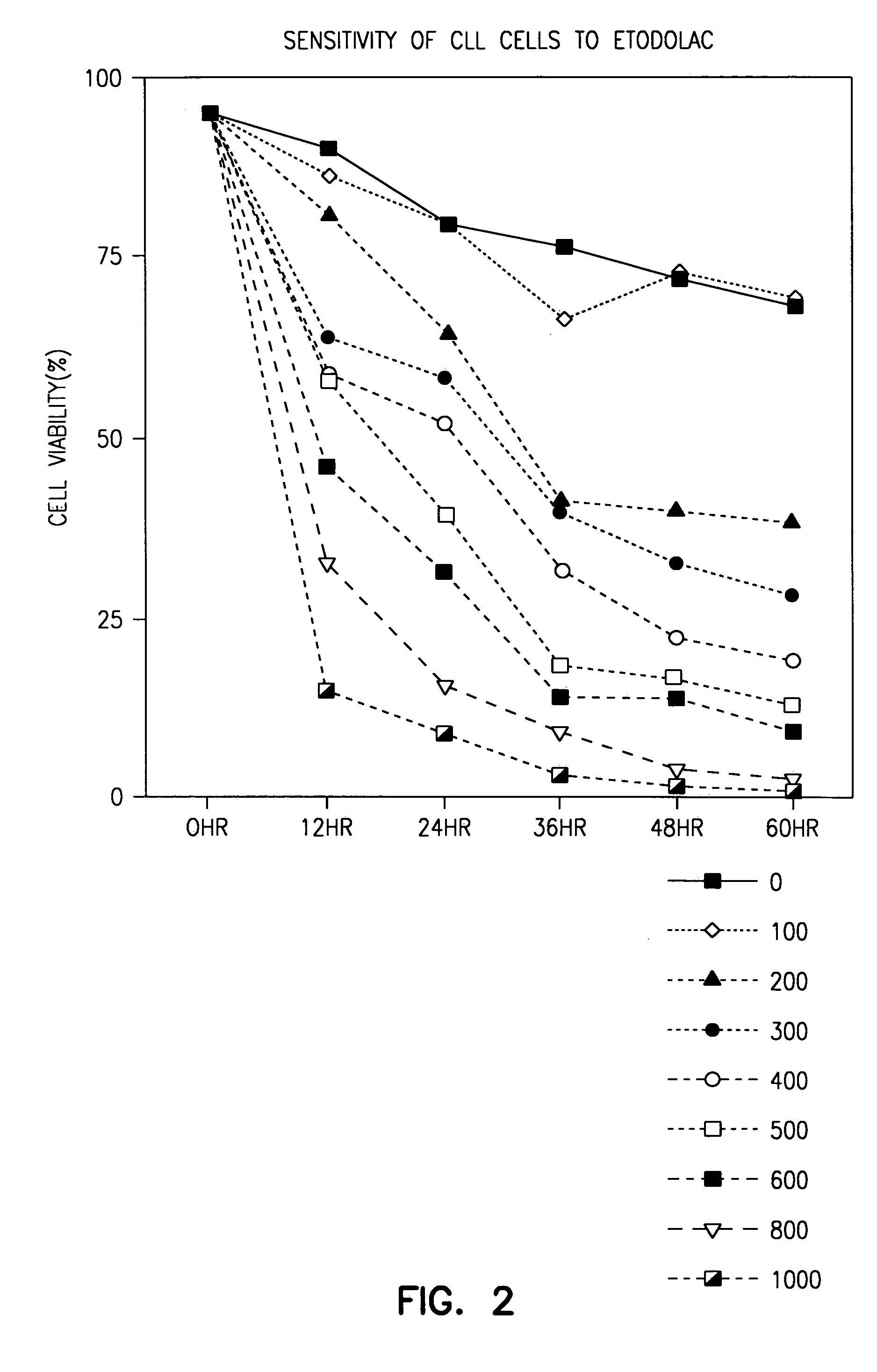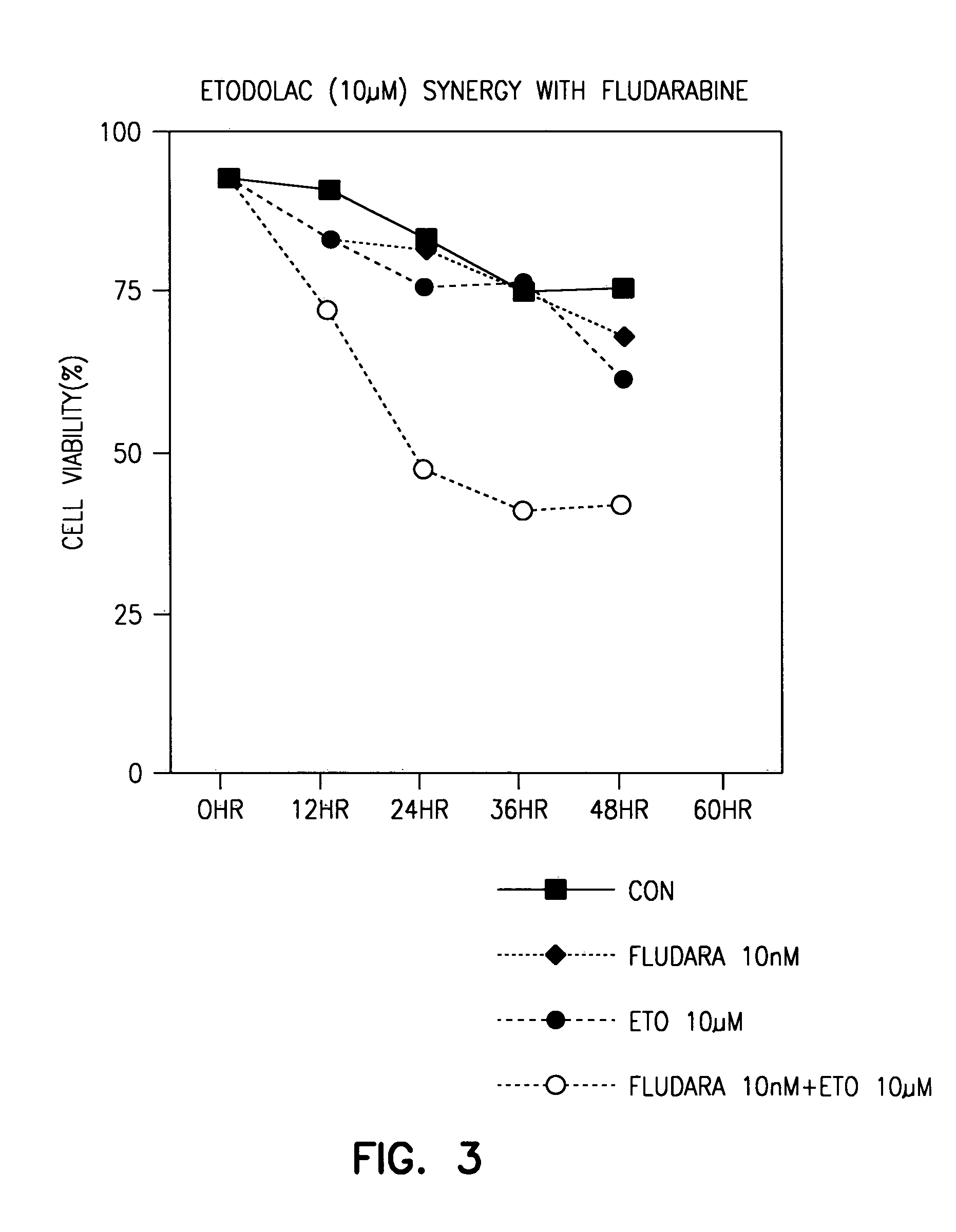Indole compounds useful for the treatment of cancer
a cancer and indole technology, applied in the field of indole compounds useful for the treatment of cancer, can solve the problems of limited treatment options for advanced disease, limited clinical usefulness of nsaids, and ineffective treatment with conventional chemotherapeutic agents such as progesterone, estramustine and vinblastin
- Summary
- Abstract
- Description
- Claims
- Application Information
AI Technical Summary
Benefits of technology
Problems solved by technology
Method used
Image
Examples
example 1
2-(1,8-Diethyl-1,3,4,9-tetrahydropyrano[3,4-b]indol-1-yl)-ethanol (1)
[0062]A solution of etodolac (2.0 g, 6.97 mmol) in dry THF (5 mL) was added dropwise to 1M LiAlH4 in THF (10.5 mL, 10.5 mmol, 1.5 eq) over five minutes and stirred at room temperature overnight under argon. The resulting mixture was then slowly quenched with EtOAc and poured over water to form an emulsion. The emulsion was filtered, and the aqueous layer was separated and extracted twice with EtOAc. The three organic phases were combined, washed with brine, dried with Na2SO4, concentrated, and purified by column chromatography using 50:50:EtOAc:Hexane to give a yellow oil (1.87 g, 98%): 1HNMR (CDCl3, δ TMS): 0.95 (t, 3H), 1.36 (t, 3H), 1.96 (m, 2H), 2.14 (m, 2H), 2.68 (br, OH), 2.81 (m, 2H), 2.83 (q, 2H), 3.70 (m, 2H), 4.07 (m, 2H), 7.02–7.39 (m, 3H, Ar—H), 7.74 (br, 1H, NH). MS+: m / z 296 (MNa+). MS−: m / z 308 (MCl−), 272 ([M−H]−).
example 2
1,8-Diethyl-1-(2-methoxyethyl)-1,3,4,9-tetrahydropyrano[3,4-b]indole (2)
[0063]To a solution of compound 1 (348 mg, 1.27 mmol) in dry THF (5 mL) under argon, 60% NaH in mineral oil (64 mg, 1.59 mmol, 1.25 eq) was added in a portion-wise manner. After stirring for thirty minutes, MeI (99 μL, 1.59 mmol, 1.25 eq) was added dropwise, and the reaction was stirred for 2 days at room temperature. The resulting mixture was diluted with brine and extracted three times with Et2O. The combined organic phases were dried with Na2SO4, concentrated, and purified by column chromatography using 20:80:EtOAc:Hexane to give a yellow-white solid (228 mg, 62%): mp 125–126° C. 1HNMR (CDCl3, δ TMS): 0.86 (t, 3H), 1.37 (t, 3H), 1.94 (m, 2H), 2.15 (m, 2H), 2.78 (t, 2H), 2.85 (q, 2H) 3.37 (s, 3H), 3.52 (m, 2H), 4.00 (m, 2H), 6.99–7.38 (m, 3H, Ar—H), 8.43 (br, 1H, NH). MS−: m / z 286 ([M−H]−). Anal. (C18H25NO2): C, H, N.
example 3
1,8-Diethyl-1-(2-fluoroethyl)-1,3,4,9-tetrahydropyrano[3,4-b]indole (3)
[0064]To a stirred solution of compound 1 (136 mg, 0.5 mmol) in CH2Cl2 (2 mL) at −40° C. under argon, DAST (396 μL, 3.0 mmol, 6.0 eq) was slowly added in a dropwise manner. The resulting mixture was allowed to warm to room temperature and stirred for one hour before being cooled to 0° C. and quenched with MeOH (1 mL). The mixture was stirred an additional thirty minutes at room temperature, and then saturated NaHCO3 (10 mL) was added dropwise. The resulting aqueous layer was extracted three times with CH2Cl2. The combined organic phases were dried with Na2SO4, concentrated, and purified by column chromatography using 5:95:EtOAc:Hexane to give a yellow-white solid (45 mg, 33%): mp 118–119° C. 1HNMR (CDCl3, δ TMS): 0.88 (t, 3H), 1.37 (t, 3H), 1.94 (m, 2H), 2.29 (m, 2H), 2.78 (m, 2H), 2.86 (q, 2H), 3.99 (m, 2H), 4.57 (qq, 2H), 7.03–7.38 (m, 3H, Ar—H), 7.65 (br, 1H, NH). MS−: m / z 310 (MCl−), 274 ([M−H]−). Anal. (C17H...
PUM
| Property | Measurement | Unit |
|---|---|---|
| temperature | aaaaa | aaaaa |
| v/v | aaaaa | aaaaa |
| pH | aaaaa | aaaaa |
Abstract
Description
Claims
Application Information
 Login to View More
Login to View More - R&D
- Intellectual Property
- Life Sciences
- Materials
- Tech Scout
- Unparalleled Data Quality
- Higher Quality Content
- 60% Fewer Hallucinations
Browse by: Latest US Patents, China's latest patents, Technical Efficacy Thesaurus, Application Domain, Technology Topic, Popular Technical Reports.
© 2025 PatSnap. All rights reserved.Legal|Privacy policy|Modern Slavery Act Transparency Statement|Sitemap|About US| Contact US: help@patsnap.com



